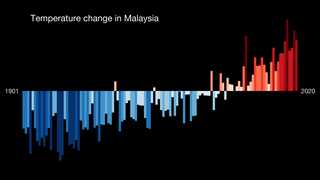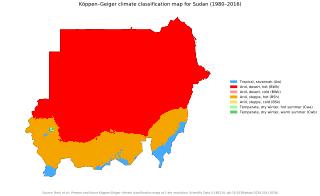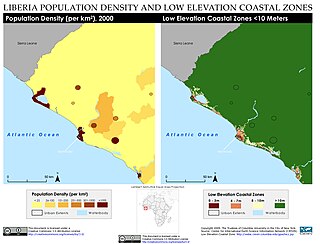
The Geography of Kenya is diverse, varying amongst its 47 counties. Kenya has a coastline on the Indian Ocean, which contains swamps of East African mangroves. Inland are broad plains and numerous hills. Kenya borders South Sudan to the northwest, Uganda to the west, Somalia to the east, Tanzania to the south, and Ethiopia to the north. Kenya currently faces border disputes with South Sudan over the Ilemi Triangle and with Somalia over Jubbaland where, if the Somalian Government gives it up, it could be a new part of Kenya, which would bring the total land area of Kenya to approximately 692,939 km2.

Globally, Nepal is ranked fourth in terms of vulnerability to climate change. Floods spread across the foothills of the Himalayas and bring landslides, leaving tens of thousands of houses and vast areas of farmland and roads destroyed. In the 2020 edition of Germanwatch's Climate Risk Index, it was judged to be the ninth hardest-hit nation by climate calamities during the period 1999 to 2018. Nepal is a least developed country, with 28.6 percent of the population living in multidimensional poverty. Analysis of trends from 1971 to 2014 by the Department of Hydrology and Meteorology (DHM) shows that the average annual maximum temperature has been increasing by 0.056 °C per year. Precipitation extremes are found to be increasing. A national-level survey on the perception-based survey on climate change reported that locals accurately perceived the shifts in temperature but their perceptions of precipitation change did not converge with the instrumental records. Data reveals that more than 80 percent of property loss due to disasters is attributable to climate hazards, particularly water-related events such as floods, landslides and glacial lake outburst floods (GLOFs).

Climate change in Pakistan is a major issue for the country. Pakistan is highly vulnerable to climate change. As with the changing climate in South Asia as a whole, the climate of Pakistan has changed over the past several decades, with significant impacts on the environment and people. In addition to increased heat, drought and extreme weather in parts of the country, the melting of glaciers in the Himalayas has impacted some of the important rivers of Pakistan. Between 1999 and 2018, Pakistan ranked 5th in the countries affected by extreme weather caused by climate change. Pakistan is prone to a range of natural disasters, including cyclones, floods, drought, intense rainfall, and earthquakes. According to scientific research, climate change played a substantial role in the devastating floods of 2022, which had a direct impact on over 30 million people in Pakistan, resulting in the loss of lives, damage to public infrastructure, and displacement from homes. Climate change poses a significant menace to Pakistan's economy and security.

Climate change in Suriname is leading to warmer temperatures and more extreme weather events in Suriname. As a relatively poor country, its contributions to global climate change have been limited. Because of the large forest cover, the country has been running a carbon negative economy since 2014.

In Afghanistan, climate change has led to a temperature increase of 1.8 °C since 1950. This has caused far-reaching impacts on Afghanistan, culminating from overlapping interactions of natural disasters, conflict, agricultural dependency, and severe socio-economic hardship.

Climate change is having a considerable impact in Malaysia. Increasing temperatures are likely to greatly increase the number of heatwaves occurring annually. Variations in precipitation may increase the frequency of droughts and floods in various local areas. Sea level rise may inundate some coastal areas. These impacts are expected to have numerous environmental and socioeconomic effects, exacerbating existing environmental issues and reinforcing inequality.

Climate change in Ghana is impacting the people in Ghana in several ways as the country sits at the intersection of three hydro-climatic zones. Changes in rainfall, weather conditions and sea-level rise will affect the salinity of coastal waters. This is expected to negatively affect both farming and fisheries.

Climate change in Tanzania is affecting the natural environment and residents of Tanzania. Temperatures in Tanzania are rising with a higher likelihood of intense rainfall events and of dry spells.
Climate change in Somalia refers to changes in the climate in Somalia and the subsequent response, adaption and mitigation strategies of the country. Climate models predict that the East Africa region is likely to experience both near-term alterations in climate such as warmer temperatures, changes in the frequency and intensity of extreme events, and decreased precipitation, as well as long-term shifts such as sea level rise.

Climate change in Senegal will have wide reaching impacts on many aspects of life in Senegal. Climate change will cause an increase in average temperatures over west Africa by between 1.5 and 4 °C by mid-century, relative to 1986–2005. Projections of rainfall indicate an overall decrease in rainfall and an increase in intense mega-storm events over the Sahel. The sea level is expected to rise faster in West Africa than the global average. Although Senegal is currently not a major contributor to global greenhouse gas emissions, it is one of the countries most vulnerable to climate change.

In Sudan, climate change has caused an increase in temperatures, a decline in rainfall and driven desertification. Climate change poses significant challenges for rainfed agriculture and therefore the entire economy. Analysis of weather patterns suggest drought conditions and other extreme weather increased in Sudan during the 20th century. The relationship between climate change, water conflict and the war in Sudan has also been a topic of academic debate.

Climate change is a significant threat to Madagascar's environment and people. Climate change has raised temperatures, made the dry season longer and has resulted in more intense tropical storms. The country's unique ecosystems, animal and plant life are being impacted.

Climate change is posing an increasing threat to global socio-economic development and environmental sustainability. Developing countries with low adaptive capacity and high vulnerability to the phenomenon are disproportionately affected. Climate change in Kenya is increasingly impacting the lives of Kenya's citizens and the environment. Climate Change has led to more frequent extreme weather events like droughts which last longer than usual, irregular and unpredictable rainfall, flooding and increasing temperatures.

Vietnam is among the most affected countries by global climate change. A large number of studies show that Vietnam is experiencing climate change and will be severely negatively affected in coming decades. These negative effects include sea level rise, salinity intrusion and other hydrological problems like floods, river mouth evolution and sedimentation. Natural hazards such as cold waves, storm surges will increase in frequency, with negative effects on the country's development, infrastructure and economy.
Climate change in Guatemala is a serious issue as Guatemala is considered one of 10 nations most vulnerable to the effects of climate change. In 2010, Guatemala "ranked second in the world on the Global Climate Risk Index, which indicates the level of exposure and vulnerability to extreme events." Both commercial agricultural production and subsistence farming have declined, and thus subsistence farmers find it more difficult to find work as day laborers when their own harvests fail. About 300,000 subsistence farmers reported crop loss due to drought in 2018. About half of Guatemala's workforce is in the agricultural sector. Poor crop yields due to climate change have been identified as a factor in migration to the United States.
Climate change in Honduras is a major challenge for Honduras as it is one of the countries which is most at risk from climate change. The frequency of natural disasters in Honduras, such as floods, mudslides, tropical storms and hurricanes, is expected to increase as climate change intensifies. Over 40 percent of Hondurans work in the agricultural sector, which is impacted by increasing temperatures and reduced rainfall. However, agriculture could be dramatically impacted, which can hurt certain households in Honduras. Sanitation and food access is a major issue that is increasing due to climate change, as well as the loss of habitats for several endangered organisms.

Climate change in Liberia causes many problems as Liberia is particularly vulnerable to climate change. Like many other countries in Africa, Liberia both faces existing environmental issues, as well as sustainable development challenges. Because of its location in Africa, it is vulnerable to extreme weather, the coastal effects of sea level rise, and changing water systems and water availability. Climate change is expected to severely impact the economy of Liberia, especially agriculture, fisheries, and forestry. Liberia has been an active participant in international and local policy changes related to climate change.

Climate change in the Middle East and North Africa (MENA) refers to changes in the climate of the MENA region and the subsequent response, adaption and mitigation strategies of countries in the region. In 2018, the MENA region emitted 3.2 billion tonnes of carbon dioxide and produced 8.7% of global greenhouse gas emissions (GHG) despite making up only 6% of the global population. These emissions are mostly from the energy sector, an integral component of many Middle Eastern and North African economies due to the extensive oil and natural gas reserves that are found within the region. The region of Middle East is one of the most vulnerable to climate change. The impacts include increase in drought conditions, aridity, heatwaves and sea level rise.
Climate change is having a range of impacts in the Republic of Ireland. Increasing temperatures are changing weather patterns, with increasing heatwaves, rainfall and storm events. These changes lead to ecosystem on land and in Irish waters, altering the timing of species' life cycles and changing the composition of ecosystems. Climate change is also impacting people through flooding and by increasing the risk of health issues such as skin cancers and disease spread. Climate change is considered to be the single biggest threat to Ireland according to the head of the Defence Forces of Ireland, Mark Mellett.

Malawi is a land-locked country in southeastern Africa situated along the southernmost arm of the East African Rift-Valley System between latitudes 9°22’ and 17°03’ south of the equator, and longitudes 33°40’ and 35°55’ east of the Greenwich meridian. It shares borders with Tanzania in the north and northeast, Mozambique in the southwest, south, and east, and Zambia in the west. Malawi is highly vulnerable to the effects of climate change as the vast majority of Malawians rely on small-scale, rain-fed agriculture, making them highly dependent on weather patterns. Climate change increasingly exacerbates droughts, flooding, and inconsistent rainfall—contributing to food insecurity and threatening to derail progress toward Malawi’s goal of self-reliance.


















